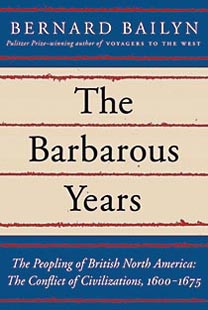Review: The Barbarous Years: The Peopling of British North America: The Conflict of Civilizations, 1600-1675
By Bernard Bailyn
Share
Like all descendants of colonial peoples, modern Americans have some gentrified versions of their early history—stories of founding a city shining on a hill—versions that Harvard historian Bailyn does not so much reject out of hand as hold up to the light, so they can be seen fully rounded, warts and all. There may have been two main protagonists involved, indigenous Americans and European newcomers, but that binary division masks the endless fissures within each, from the brutally expansive Powhatan empire, still being carved out of Virginia as the English arrived, to the latter’s religious and class divisions. More importantly, as Bailyn shows in his beautifully written introduction, natives and aliens were far more alike than we are accustomed to thinking.
Europeans marvelled at the Indians’ technical expertise, especially in boat-building and artifacts of war—their powerful bows were more accurate than muskets, while their close-combat weapons were as effective as any in the Old World. Christian Europeans were usually less impressed with native spiritual life, but from the start some were aware of its sophistication; as Bailyn notes, “centuries would pass before European civilization would match the Indians’ understanding of the importance of dreams.”
And if the natives’ lives were both bolstered and circumscribed by invisible but omnipresent supernatural forces, so too were the Europeans’. “For the English, the powers of soothsayers, conjurors, cunning men, wizards, diviners, and witches were not abnormal but commonplace and realistic,” especially in North America, known to be “one of the dark places of the Earth.” Both groups feared breaches of the peace, spiritual or political, and punished them, just as they waged war, with savage violence.
And with both sides in crises that began even before their first encounters—the Indians coping with new economic modes of life and epidemics, the Europeans failing in what they most wanted (the recreation of the Old World in the New)—the wars they waged, and the patterns they set for the following centuries, fully justify Bailyn’s title.
Visit the Maclean’s Bookmarked blog for news and reviews on all things literary
